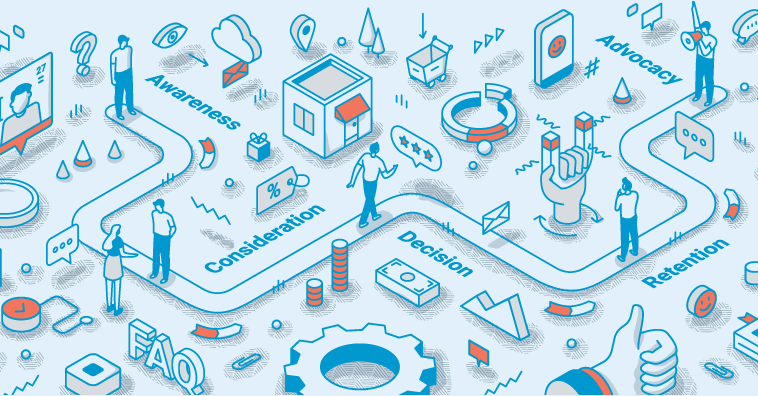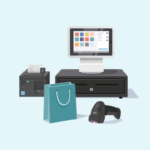A retail purchase is so much more than a sales transaction. In today’s omnichannel retail environment, a purchase happens in the midst of an ongoing customer journey that starts with awareness and continues through repeat purchases and long-term brand loyalty. While customer journeys can take different paths, understanding the primary opportunities to engage, interact, and influence customers along the way is a must for retailers looking to grow.
One of the best ways to understand your customer’s journey is to map it out, touchpoint by touchpoint. By putting yourself in your target customer’s shoes, you’ll gain a fresh perspective on your shopping experience across channels and identify potential obstacles or points of friction. Best of all, you’ll be able to anticipate and implement enhancements to your shopping experiences so that you continue to meet – and exceed – customer expectations. The benefits are tangible. Analysis shows that organizations utilizing customer journey maps are twice as likely to outperform their competitors.
Define your “who” before you map
Today’s consumers expect retailers to deliver an increasingly personalized experience. And highly personalized customer experiences help retailers deliver differentiators that competitors can’t easily replicate, which produce estimated revenue increases of 5 to 15 percent. To maximize the impact, customer journey maps can’t be one-size-fits-all. Instead, before you jump into journey mapping, it’s important to spend some time building profiles of your store’s target customer segments.
Retail customer profiles should be a mix of external and internal data. Using over-arching market data from sources like the U.S. Census, local Chamber of Commerce, and industry-related resources, you can define the demographic characteristics of your target customers, including age range, gender, and income. You can also estimate the size of different market segments.
In addition, tap into your point-of-sale (POS) system for a wealth of data about your current customer base. The best POS solutions function as a centralized data hub for retailers, integrating customer, sales, and inventory data across in-person and online channels. Your POS system should help you capture, monitor, and report on who your customers are, how they’re engaging with you, and what they’re buying. For example, by mining the data within your POS system, you can determine the attributes your best customers have in common, like gender, age ranges, and geographic locations.
Related: Niche Markets: How Retailers Can Narrow Their Target
5 steps to create a customer journey map
1. Map out the high-level journey by persona.
Most retailers can identify three to five distinct customer personas within their target market segments. Each of these personas will interact with your store a little differently. For example, you may have in-person or e-commerce-only shoppers, omnichannel shoppers, and anonymous browsers.
To start developing your customer journey maps, think about how each persona engages with you from awareness and arrival (either in-store or online) through their browsing, buying, and post-sale experiences.
2. Detail potential interactions across channels.
Once you have the high-level engagement opportunities identified by persona, it’s time to build out the details by documenting all of the potential types of interactions customers can have at each point of their buying journey. Use the following questions to inspire your brainstorming.
- Awareness: How do prospective customers become aware of your store? (Advertising, online search, walking or driving by your physical location, social media, customer referrals, etc.)
- Arrival: What do customers see when they arrive at your store (in-person and online)? How are they greeted? What do they typically do first?
- Browsing: How do they shop? Are they looking for something specific? What path do they take through your physical store? How do they progress through the website?
- Buying: What triggers them to buy? (Or to leave without making a purchase?) What are the most common purchases by new customers? How does that differ from repeat customers? Do they opt to browse online but purchase in-store or do they choose a buy online, pick up in store (BOPIS) option? What payment methods do they typically use?
- Post-sale: What follow-ups do you have in place? (Emails, thank you notes, coupons, re-engagement marketing for dormant customers, etc.)
For all of the above, find opportunities to validate your assumptions by leveraging the data captured by your POS system and by asking customers via interviews, surveys, or focus groups.
3. Identify – and fix – potential pain points.
As you map out the customer journeys for each persona, you should spot gaps and barriers in your processes. These can range from customers not being able to get the information they need to asking them to supply too much information at checkout. Other pain points could be inventory shortages that cause shoppers to go elsewhere or difficulties searching for and finding items on your e-commerce site.
Pay extra attention to your purchase transaction experiences. For online shoppers, what percentage are completing the purchase process? For those who don’t, are there specific points where they abandon the items in their shopping carts? For in-person shoppers, how long do they have to wait in line at peak times? How long does it take for associates to ring up and package their purchases?
When addressing customer pain points, prioritize the ones that will have the biggest impact and, whenever possible, test different options.
Related: Does Your Store’s Customer Experience Stand Out?
4. Imagine enhancements.
Beyond identifying existing gaps and pain points, use your customer journey maps to inspire creativity. Involve your team – from in-store associates to website developers – throughout the process to not only inform the mapping but to also imagine enhancements.
The key to anticipating what your customers will value is ensuring enhancements are well-defined and measurable. For example, “streamline checkout” is likely too broad, but “reduce required customer profile fields at checkout” is more precise and actionable. Use the following questions to generate discussion and ideas from your team.
- Which persona are we aiming to help with the proposed enhancement?
- Where does it fit in the persona’s customer journey?
- What’s needed to implement the proposed enhancement? (POS data, processes, people resources, etc.)
- How can we measure the impact of the proposed enhancement? (Sales, conversion rates, repeat purchase rates, customer satisfaction, etc.)
5. Track and update.
In the dynamic and competitive retail environment, customer journey mapping isn’t a once-and-done exercise. Look at your customer journey maps as ever-evolving documents that you monitor regularly and refresh as customer needs and preferences change. As a best practice, set annual or quarterly timeframes to review your journey maps, compare them with your ongoing POS reports, and identify opportunities for adjustments or additional persona maps.
POSIM is an integrated point-of-sale and inventory management system with the data and reporting capabilities to help retailers understand their target customers and map out customer journeys that drive increased sales and satisfaction. Find out which POSIM plan is right for your business and ask us for a demo today.












